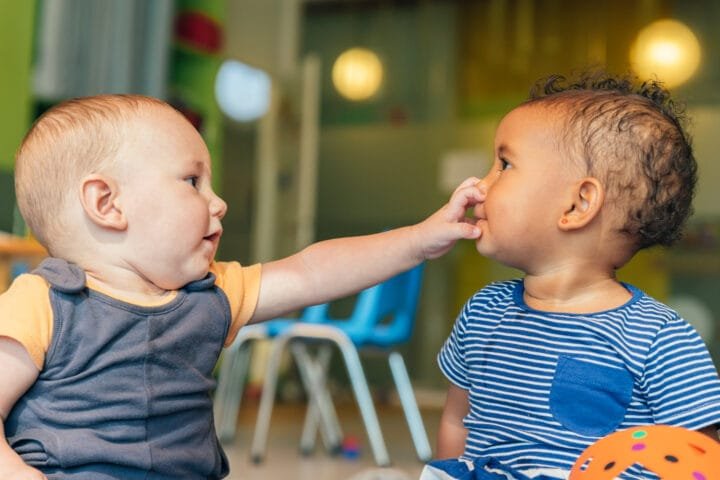How to Make Math Fun: The Kitchen Hack That Transformed My Daughter’s F to an A+

What Age Should Kids Get Their First Smartphone? The Data Might Surprise You
Why Encouraging Kids to Write Thank-You Notes Is the Parenting Win You Didn’t Know You Needed
Protecting the Next Generation: How to Teach Kids About Online Scams and Fraud in 2025
The Truth About Teaching Kids About Gender Equality That Schools Won’t Tell You
The Ultimate Parent’s Guide to Teaching Kids About Investing
How to Stop Toddler from Biting Other Children: Why My ‘Energy Dump’ Method Works Every Time
Hidden Signs Your Child Might Be Gifted – From a Mom Who’s Been There!
Warning: Don’t Help Your Child’s Fear of the Dark Until You Read This First!
The Netflix-Inspired Secret to Teaching Kids About Public Speaking
Digital Hearts vs. Paper Cards: The Surprising Truth About Modern Valentine’s Day
Teaching Kids About Self-Defense: What Schools Don’t Want You to Know
A Real Mom’s Guide to Choosing the Right Preschool
I Drank Apple Cider Vinegar During Pregnancy – The Results Left My Doctor Speechless!
10 Winter Activities That Made My Kids Forget About Their Screens
Should Teens Be Able to Drive at 15? Safety Experts Reveal Stunning Facts
Revolutionary Guide to Teaching Kids the Value of Hard Work
Genius Ways to Encourage Kids to Try New Things
Why Smart Kids Struggle: The Learning Styles Mystery Finally Solved!
What Age Should Kids Get Their First Smartphone? The Data Might Surprise You

The Controversial Question: What Age Should Kids Get Their First Smartphone?
It was Wednesday evening, just past 6:30 PM. My nine-year-old, Sophie, sat across the table, arms crossed, her spaghetti untouched. Her face was stern, but her eyes had that glassy, about-to-tear-up look. “Mom, I’m the only kid in school who doesn’t have a phone. Even Max has one—and he’s younger than me!”
My husband, Adam, raised an eyebrow at me, silently reminding me of our pact: no smartphones until middle school. Still, my resolve faltered for a moment. Was I being unreasonable? Was Sophie really the only one without a smartphone? Was she right to feel left out?
Parenting in the digital age feels like navigating a minefield. Everywhere you step, there’s a big decision waiting to detonate. But this? This one felt monumental. It wasn’t just about giving Sophie a device; it was about her childhood, her safety, and, if I’m honest, my sanity.
The Reality of Smartphones and Kids
Did you know that by the time kids enter fourth grade, 42% of them already own smartphones? By fifth grade, that number jumps to over half, and by middle school, it’s nearly universal. Phones have become the modern security blanket for kids and a rite of passage for tweens.
And yet, this isn’t an easy decision. On the one hand, there’s the worry that delaying a phone could isolate Sophie socially. On the other, there’s the nagging fear that handing her one too soon could expose her to risks she’s not ready to face.
If you’re on this boat too, let me tell you—you’re not alone. This is one of modern parenting’s greatest dilemmas, and it’s not just about when your child gets a phone. It’s about understanding the why and how behind that decision.
The Science of Readiness: Is Their Brain Prepared?
When it comes to your kids and smartphones, the first place to start is with their little (but incredible) brains. The prefrontal cortex, the part of the brain that handles decision-making, impulse control, and focus, doesn’t fully develop until their mid-20s. That means even the most confident, independent 10-year-old may struggle to resist the siren call of notifications, apps, and games.
Let me give you an example. Three months ago, Sophie was using my tablet to finish her homework, a math app I downloaded to help with fractions. Ten minutes later, I walked back into the room to find her giggling at some silly YouTube video about cats riding Roombas. “Just one more, Mom!” she said when I asked her to get back to math.
That moment wasn’t just a parenting battle; it was science in action. Studies show that kids are especially vulnerable to distraction because their brains crave novelty. Dopamine—the chemical that triggers feelings of pleasure and reward—spikes every time something new pops up. Notifications, social media feeds, and even innocent apps like YouTube can create an endless loop of “just one more.”
The data is compelling. Research shows that children who get smartphones before age 13 face real risks:
- 50% report feeling addicted to their devices.
- 56% see drops in academic performance.
- 68% of experience reduced sleep quality due to late-night phone use.
Let’s pause for a second here. Sophie’s bedtime routine includes reading Anne of Green Gables with me in her cozy yellow room. She sleeps soundly, like clockwork, by 9 PM. The thought of her scrolling through Instagram at midnight instead? No, thanks.
Social Dynamics: The FOMO Is Real
“But all my friends have one!”
If you’ve ever heard this phrase, let me assure you, it’s not just a statement, it’s a weapon in the Great Phone Debate. Sophie’s insistence wasn’t just about wanting a smartphone for herself. It was about belonging.
Social dynamics for kids today are wild compared to what we had growing up. I mean, remember when “status” at school was defined by how cool your backpack was? For kids now, it’s all about group texts, Instagram Stories, and TikTok trends.
According to a study by Common Sense Media, 53% of kids who own smartphones feel social pressure to be online constantly. It’s because they equate having a phone with being part of the community. Missing out on group chats? That’s the modern equivalent of being the last kid picked for dodgeball.
Last year, my neighbor’s son, Ethan, got his first phone at age 10. For a while, he was the life of his fourth-grade group chat. But then it turned sour. Ethan became the target of cyberbullying—mean comments about his haircut escalated until he begged his mom to take the phone away.
That story stuck with me. Yes, phones can connect kids to their peers, but they can also amplify childhood dramas in ways we never had to deal with.
Building Digital Literacy Before the Device
Here’s the major game-changer for me: a smartphone isn’t just a device—it’s a gateway into an entire world. And as parents, it’s our job to teach our kids how to navigate that world safely before handing over the keys.
That’s why we started something we call “Tech Fridays” in our house. Every Friday evening, we sit down after dinner to talk about one digital skill—kind of like a family workshop.
One week, we discussed online privacy, teaching Sophie what’s safe to share (and what’s definitely not). Another week, we talked about online predators and how to spot fake friend requests. And just last month, we practiced using the Screen Time app to set limits for specific apps.
You know what’s funny? Sophie turned these Tech Fridays into a competition. “Mom, quiz me again! How do I stop location tracking on Instagram?” Watching her nail every answer feels like a tiny parenting victory each time.
And isn’t that the goal? To help our kids develop digital skills BEFORE they’re handed something as powerful as a smartphone.
Alternatives to Smartphones: Start Small
Okay, let’s talk about the middle ground here. Just because your child isn’t ready for an iPhone or Android doesn’t mean there aren’t any options. The beauty of today’s tech landscape is that alternatives exist, and some of them are brilliant.
We started Sophie out with a Gizmo Watch. It looks like a fun wrist gadget but functions as a beginner’s communication device. She can call or text us, her grandparents, and one or two close friends. No internet, no social media—just the basics.
Those first few months were eye-opening. Sophie’s creative streak went wild. She used her watch to set step goals, coordinating mini scavenger hunts with her cousins. “Mom, I hit 10,000 steps today!” she announced one weekend, her face beaming with pride.
Now, we’ve moved on to a Pinwheel phone. It’s a step up from the watch but still keeps things minimal with no social media or games, just practical apps and parental controls. Our approach has been gradual, and honestly? It’s working.
The Transition to Smartphones: A Balanced Approach
After about six months with the Gizmo Watch, Sophie surprised me. One Friday evening during our Tech Fridays, she casually asked, “Mom, do you think I’m ready for a real phone?” I felt my stomach tighten. Honestly, I wasn’t sure. But instead of brushing it off, I leaned into the conversation.
“Well,” I asked her, “what do you think being ready looks like?”
She thought for a moment, then said, “I think it means you can trust me to follow the rules and use it responsibly.” To be fair, she had a point. Sophie had been honoring our agreements with her watch—no late-night chatting, no pestering classmates—and it was clear she’d taken to heart the lessons we’d covered on Fridays.
This is where we made use of what I call “Gradual Access Parenting.” Instead of handing her an iPhone with full access to the internet, we introduced her to a Light Phone III. Think of this as the simplicity of those old Nokia phones from the early 2000s but with modern features, allowing calls, texts, and a few necessary tools—without the distractions of social media or addictive apps.
The difference was night and day. Sophie appreciated the gift but also respected its limits. She even said, “Mom, I think the simplicity is kind of cool.” That small moment validated our approach and reaffirmed that easing kids into technology, rather than jumping straight into a fully connected device, can build confidence and trust on both sides.
Creating a Family Digital Constitution
As Sophie continued to grow with her new device, it became clear that boundaries were non-negotiable. Smartphones aren’t just something you buy and forget about. They require rules, enforcement, and yes, open conversations about boundaries.
One Sunday afternoon, as we lingered over our post-brunch coffee, Adam suggested something genius: “Why don’t we create a family tech contract?” We instantly got buy-in from Sophie after cleverly renaming it a “Digital Constitution” (it felt more official to her this way).
With Sophie leading the charge, we drafted a set of guidelines that everyone in our home had to follow—yes, even Adam and me. Some examples included:
- No devices at the dinner table.
- Screens get turned off at least an hour before bedtime.
- Phones stay in the living room overnight—no exceptions.
This little exercise became a family bonding moment. Sophie even suggested using timers on apps to prevent overuse and made a rule that if someone accidentally left their phone at the table during meals, they’d owe the others five minutes of uninterrupted attention.
Let me tell you, the constitution didn’t just foster accountability; it turned what could have been a battle over tech into a collaborative, family-wide effort.
Signs Your Child Might Be Ready for a Smartphone
You might be asking yourself when the right time is to take this leap. I’ve been there. Ultimately, it depends on the individual child and your family’s dynamics. But as a guide, we developed what I now like to call the “READY” checklist:
- Responsibility: Is your child following through on their commitments, like homework, chores, or agreements about smaller tech use?
- Emotional Maturity: How does your child handle disagreements or peer pressure? Can they pause and think before reacting emotionally?
- Awareness: Does your child understand the risks of oversharing online or getting sucked into addictive apps?
- Device-Free Habits: Can your child enjoy downtime without feeling glued to a screen?
- Your Involvement: Are you prepared to monitor their smartphone use and stay actively engaged in their digital life?
For Sophie, the answer to these questions gradually shifted from “maybe” to “yes.” We knew she was ready when she began self-regulating, like choosing to leave her Light Phone in the kitchen overnight without us needing to remind her.
The Role of Peer Pressure
Let’s circle back to that dreaded argument: “Everyone else has one.”
No parent escapes this line unscathed. But here’s a little secret: when Sophie told me that everyone in her class had a smartphone, I fact-checked it. Turns out, fewer than half did. They likely knew kids who had one, but they weren’t all glued to devices like she suggested.
I learned this the hard way early on. I once caved into peer pressure—my own peer pressure as a parent. When Sophie was in second grade, a fellow mom in my social circle bragged about how her daughter already had her own tablet, and it doubled as a learning device. Well, I ran out and bought Sophie a tablet the very next week. It was a disaster. She had fun at first but quickly got distracted and sneaky with it, and we ended up scaling back entirely. Lesson learned: you’re the one driving the parenting boat—not your child’s classmates, not other parents, and certainly not the technological trends in your community.
That said, a healthy social life is vital. When Sophie eventually got her Light Phone, she made it clear: “It’s not about texting people all day. I just like knowing I can make plans with my friends!” Having limited but functional tech actually made her feel empowered instead of being left out.
Digital Literacy: Non-negotiable
If there’s one takeaway, I hope you embrace, it’s this: kids MUST grasp digital literacy before owning a smartphone. Period.
Sophie didn’t just get to dive into the world of apps without a snorkel. Every Friday, during what we called Tech Fridays (our mini course on all things digital), we covered topics that seem simple to adults but are revolutionary to kids:
- Online Privacy: How to keep personal information safe.
- Spotting Scams: Recognizing fake giveaways or phishing messages.
- Time Management: Setting limits so tech doesn’t dominate their free time.
One particular Tech Friday stuck out. I was showing Sophie how location tracking worked on social media apps like Instagram. Her jaw dropped. “Wait, someone could figure out where I am from my photos? That’s so creepy!” That single conversation made her more skeptical about the online interactions—a skill every child needs in today’s digital age.
Closing Thoughts
Looking back, I still wonder if I got everything right. Parenting is hard, and technology only makes it harder. But what I’ve realized after years of navigating this smartphone journey is that it’s less about finding the “perfect” age and more about preparing your child for the responsibility that comes with it.
It’s okay to start small. It’s okay to ask questions and set boundaries. And it’s okay to say “not yet” if your child isn’t ready.
Sophie, now 11, still uses her Light Phone on most days, but every once in a while, we let her borrow one of our smartphones for a specific purpose hiking trail map or even FaceTiming her cousin on a birthday. Each time, she handles it with care.
Parenting in the digital age is messy, but it’s also an opportunity to teach our kids independence, moderation, and mindfulness. And sure, there will be tantrums and persuasive arguments along the way (hello, middle school drama), but in the end, it’s worth the effort.
So, when you finally hear that dreaded line— “When am I getting MY phone?”—take a deep breath. Remember, you don’t need to have all the answers right away. Together with your child, you can navigate this uncharted territory and help them grow into responsible, confident digital citizens.
FAQs
There’s no universal “perfect” age—it depends on your child’s maturity, responsibility, and your family’s values. Many experts suggest waiting until at least middle school (around 12–13 years old) when kids are better prepared for the responsibilities of owning a smartphone. However, younger kids who need basic communication can start with alternatives like smartwatches or phones first.
Ask yourself: Does your child show responsibility in other areas, like managing homework, completing chores, or handling rules about screen time? Are they emotionally maturing enough to handle peer pressure, cyberbullying, and inappropriate content? Use tools like a readiness checklist to assess if they’re prepared for this responsibility.
Start with digital literacy training before they get a phone. Teach them about online privacy, recognizing scams, avoiding oversharing, and setting screen time limits. Consider starting with restricted versions of devices or apps and set parental controls to monitor their usage. Regular family discussions about smartphone use can foster trust and good habits.
Yes! There are excellent alternatives, including smartwatches like the GizmoWatch or feature phones like the Light Phone III. These devices allow basic communication (calls and texts) without the distractions of social media or access to the internet. They’re a great steppingstone for kids before transitioning to full smartphones.
Create clear rules through a family tech contract or digital constitution. Examples include no phones at the dinner table, charging devices outside the bedroom at night, and limiting screen time during homework or family time. Regular check-ins on their phone usage help reinforce boundaries while keeping communication open.
Recommend Books
The Art of Screen Time: How Your Family Can Balance Digital Media and Real Life by Anya Kamenetz: This one’s a gem! Kamenetz doesn’t give a hard-and-fast age but offers a framework for decision-making based on your family’s values and your child’s development.
“Behind Their Screens: What Teens Are Facing (and Adults Are Missing)” by Emily Weinstein and Carrie James: Though focused on teens, this book provides valuable insight into the social pressures and online experiences that influence kids’ desire for smartphones, even at younger ages.
“Digital Minimalism: Choosing a Focused Life in a Noisy World” by Cal Newport: While not directly about kids, Newport’s philosophy of intentional tech use can be eye-opening for parents grappling with smartphone decisions.



































































